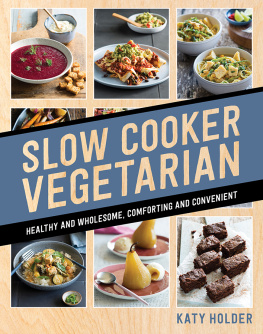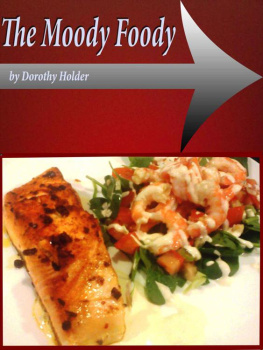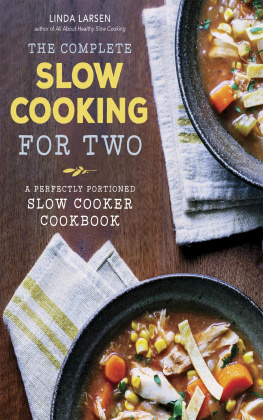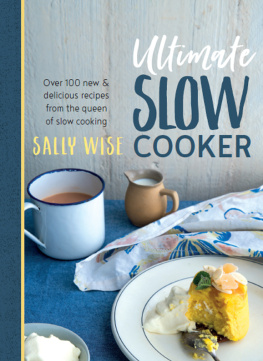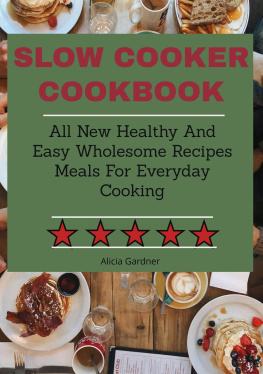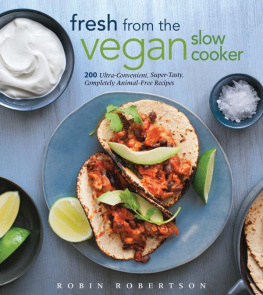
Contents Introduction Whether youve been using a slow cooker for years or have just bought your first one, this collection of vegetarian dishes is a great place to start or continue your journey. Quite often people think of slow cookers as useful pieces of equipment for cooking tough cuts of meat. However, they are equally fantastic for vegetables, allowing you to cook them gently and slowly until they are wonderfully tender and juicy or still firm, depending on the desired result. The joy of prepping and forgetting Due to the high water content of vegetables, its important not to cook them for hours and hours. So, rather than using the traditional leave for eight hours while you go to work approach, many of the recipes in this book are cooked for just three or four hours. The beauty of this timeline is that you can do some preparation, throw everything in the slow cooker, do the washing up and then have a few free hours to read stories to your kids, help them with homework, go for a walk, run errands and so on.
Best of all, after dinner, there is often only one pot to wash up! One point to remember when using a slow cooker is that, unlike cooking in an oven or on the stovetop, liquid is unable to evaporate, so its important to add much less liquid than you normally would. Dont worry if when you start your dish it looks dry. By the end of the cooking time, the vegetables will be cooked and (if intended) saucy. Cooking for the family Slow cookers are ideal for cooking healthy meals for your family because you start with predominantly fresh, whole foods and very few nutrients are lost in the cooking process. Slow cookers work differently than, say, boiling vegetables in a saucepan, as they retain all of the vegetables natural juices in the sauce, resulting in a richly flavoured, nutrient-dense dish. The recipes in this book are all vegetarian, but this doesnt mean they use only vegetables.
Many provide a complete balanced meal, including vegetables, beans and pulses, with no need for additional protein. When cooking pantry staples like pulses and beans, dried and tinned versions work equally well. Just ensure that if you are using dried pulses and beans, you soak and pre-cook as required beforehand. Slow cookers are also ideal for cooking rice and you will find plenty of recipes in this book for rice dishes, such as risotto and paella. If youd like to offer options, or introduce new flavours to kids and fussy adult eaters, this book offers topping ideas that can be used to add even more flavour or texture to many of the dishes. Put them in the middle of the table when the meal is served and let everyone choose their own.
For many kids, herbs, chilli and citrus can take a bit of time to get used to, so adding them as toppings introduces these flavours slowly. The not only adds crunch, but extra protein and healthy fats, too. And speaking of cooking for the family, weve also included desserts! When cooking desserts, keep a close eye to ensure your recipe doesnt overcook, as the size of the slow cooker can affect some of the puddings. Keep watch through the lid, resisting the temptation to keep lifting it up and letting the heat escape. When your dessert is finished, remove the lid quickly so the condensation doesnt drip onto your delicious pudding. Slow cookers are often thought of as convenient for the cooler months.
However, I like to use them in the warmer months, too, as they dont heat up the house like a stovetop or oven. The warm salad recipes in particular are great for summer lunches or dinner parties. Get them cooking early on, then concentrate on other aspects of your meal. Leave the salads to cool and then enjoy your feast. Lets get started This book is divided into chapters with recipes for soups; dals and curries; family favourites; rice, pasta and grains; warm salads and sides and of course scrumptious desserts. Since everyones slow cooker is different, most of the recipes do not require any particular size and have been tested in many different sized cookers.
Your slow cooker will probably work best when it is between half and two-thirds full. There isnt much you cant do in a slow cooker. So dig yours out from the back of your cupboard or buy one next time you are shopping and reclaim your precious time! Slow cooker tips Most slow cookers are very simple to operate with low, high and auto settings (or 1, 2 and auto), but read the instruction manual for your particular slow cooker before starting to cook. Some slow cookers have an insert pan that can be used on a stovetop and then put back to continue cooking. Many of the recipes in this book suggest frying off some ingredients before cooking in the slow cooker. If your slow cookers insert pan can be used on the stovetop, then do all the cooking in the pan; if not, use a frying pan.
The majority of ceramic insert pans cannot be used on your stovetop and will crack. Refer to the instruction manual to see if yours is suitable. If you have put your slow cookers ceramic insert in the fridge for any reason before cooking, allow it to come to room temperature before starting to cook or it may crack once it starts heating up, due to the sudden change in temperature. Never cook dried kidney beans and other kidney-shaped beans from raw in a slow cooker because the temperature isnt high enough to destroy the natural toxins found in these beans. Always soak them overnight and then boil for 10 minutes before adding.
Left to right: Toppings Cooking for the family can be tricky if one person likes a flavour but no one else does. serving toppings on the side can solve this problem. serving toppings on the side can solve this problem.
Pangrattato
(garlic and herb breadcrumbs) 1 tablespoon olive oil 30 g (1 oz/ cup) panko breadcrumbs 1 small garlic clove, crushed finely grated zest of 1 lemon 1 tablespoon finely chopped flat-leaf (Italian) parsley or basil Heat the oil in a large frying pan over mediumhigh heat. Add the breadcrumbs and cook, tossing the pan regularly for 45 minutes until the breadcrumbs are lightly golden. Add the garlic and a pinch of sea salt and cook for 1 minute more. Remove from the pan and stir in the lemon zest and your choice of herb. Lemon and dill yoghurt 150 g (5 oz) Greek-style yoghurt 1 teaspoon finely grated lemon zest 2 teaspoons lemon juice 1 tablespoon finely chopped dill Combine all the ingredients in a small bowl with a little sea salt and freshly ground black pepper. Chilli and herb oil 80 ml (2 fl oz/1/3 cup) extra virgin olive oil 1 red birds eye or long red chilli, thinly sliced basil leaves, coarsely torn or 2 tablespoons finely chopped flat-leaf (Italian) parsley Combine all the ingredients in a small bowl, season with sea salt and freshly ground black pepper and use as a drizzle at the table.

